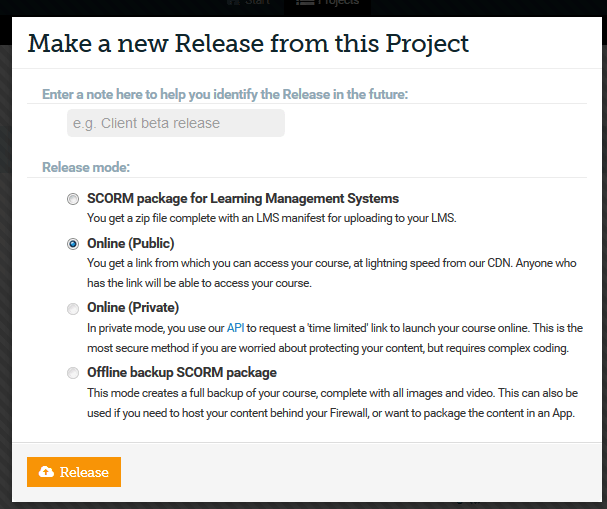5 tips to make your microlearning strategy really deliver
8 minute read
The shift from “courses to resources” has been a hot topic for more than ten years. Many elearning designers chop up their content into bite-sized chunks. But is this more micro than learning? In this article, Kirstie Greany challenges traditional perceptions and shares some ideas on how to create a successful microlearning strategy.

Microlearning: What is it?
It’s certainly a topic of huge industry debate. Many people would define microlearning as simply being about providing learners with tiny bites of learning material rather than longer form modules or courses. These tiny bites could be interactive videos, podcasts, activities, and more. But it’s their length that is key. We’re talking two to three minutes max. Generally, learners have some choice about what they use and when.
Others argue that shorter doesn’t equal better. In theory, making learning bite-sized is a great idea. We know workplace learning often happens in short windows, attention spans are finite, and no one wants to drown in content—especially when the chances of it all being relevant are slim. Even if you don’t read theory about “spaced learning,” your gut feeling would tell you that dishing up ninety concurrent pages of online content doesn’t feel right.
If you’re not sure what microlearning looks like, take a look at these 5 microlearning examples for inspiration.
At Elucidat, we feel that microlearning has more to offer than just being short. Here’s why.
Big or small learning chunks – does it matter?


On a given day, whether I eat an entire cake (i.e., the course) or munch on five or six muffins (i.e., bite-sized chunks), what’s the difference in outcome? For both, I’d probably feel a bit sick. But that’s not the point. Perhaps the cake would make me feel so full I wouldn’t be able to do anything after, whereas the muffins give me the chance to do something in-between.
Actually, the difference in performance outcome is totally dependent on how good the learning experience is in each and how it relates to me and my personal learning and performance needs and gaps. We believe that one of the pillars of people-centered learning is about time well spent – respecting the limited time people have, yet using that to the max for true added value.
Just because something is shorter doesn’t mean it’s better for learning. But there is potential to make something of the spaces in between smaller nudges of learning. But what?
How long should an elearning course be?
There’s no one-size-fits-all answer — but there is a golden rule: keep it under 15 minutes, ideally closer to 10. The reality is, modern learners are time-poor, easily distracted, and often learning on the go. Long modules? They get skipped. Smart, short training? That sticks.
This is where the microlearning methodology really delivers. By focusing each module on one clear outcome, you help learners get what they need and get back to work – faster and with more confidence.
Where microlearning can work
Structure, spacing, personalization
Where microlearning can have the edge over simpler resource-based approaches is by applying some structure, shape, or journey to how learners use the microbites.
In our interview with Neuroscientist Stella Collins, she states that repetition is fundamental to brain-friendly learning. Other studies, like those in Make it Stick, show that providing learners with regular challenges that enable them to practice applying skills, not just repeat them, in slightly new situations helps grow competence and memory more than taking challenges all in one go. This is especially the case when those challenges gently stretch learners by getting incrementally harder.
This is where a well-thought-out microlearning methodology really comes into its own and beats older “resources not courses” approaches.
We also see personalized and adaptive learning as a must for effective microlearning strategies. Why overwhelm users with an array of hundreds of shorter topics, when you can provide them with a subset of targeted starting points and recommendations tailor-made for them? Then, depending on how they do and what they need, recommend the most useful next topics for them to continue their personal learning.

Five tips to make your microlearning strategy really deliver
Here are our five quick tips to creating a microlearning strategy that delivers on the “learning” as much as it does the “micro.”
1. Start with challenges
Using an action-mapping approach or something similar, focus on the activities that will help build competence, confidence, and skills. Then, work back from that to consider what guidance, examples, expert tips, etc., learners might need to help them complete that challenge, particularly if they don’t pass it.
2. Create a scale
Work out which challenges newbies should start with and where they can go from there. You might want to create a single string of challenges that get incrementally harder. Or, in the name of choice, perhaps you offer learners a choice of challenges, all at the same level or at different levels, and each earns them different totals of points.
3. Use scores and rules to personalize the learning curve and create adaptive learning.
You can send out a challenge-based microbite on a weekly basis. Alternatively, you can let learners work through the content more freely, unlocking the next challenge or level as they go. But this is where you can be super smart. Use Rules to track their scores or opinions across multiple questions or content bites. If you know someone is struggling with something, have your authoring tool serve up an extra challenge or set of examples to help them. You can also do this if they are all-stars; stretch them even further with a more in-depth challenge.
4. Build in incentives
Consider allocating scores, badges, or some kind of reward to learners when they complete a challenge. Even a simple acknowledgment at the end to say they’ve passed will suffice. Peer-to-peer incentives are also a strong tactic to use. Use your Analytics Data to highlight how many other learners have made it to a certain level, look to leaderboards, or simply show the results of social polls.
5. Create milestones
Even if the microlearning content is covering a big expanse of skills and competencies, such as leadership skills, don’t let it go on forever. Everyone needs a break, but we also need to feel a sense of completion and greater achievement.
After ten or so challenges, build in milestones that mark when learners have achieved a certain status. Help them celebrate it with social media links, badges, certificates, and more.
How to design microlearning
Microlearning isn’t a difficult concept to grasp. If you’re responsible for creating or delivering online training and are curious as to how to switch to microlearning, the good news is that there isn’t much to learn.
The change has more to do with a mental shift rather than a whole new way of designing. Rather than delivering an hour-long course, the microlearning methodology encourages breaking content into bite-sized nuggets. Easy, right?
There’s no official right or wrong length for microlearning. Most experts suggest two to five minutes as being optimal. However, the amount of time per lesson is largely irrelevant – it’s the content that is important. If each lesson is under 15 minutes, it can be classed as microlearning.
The key concept to remember is that you’re taking one learning objective and allocating that to a single item of content (I’m calling these “lessons”). If you stick to one learning outcome per microlearning lesson, you’re good to go.
How many lessons per course? Well that’s up to you, but a good rule of thumb would be a maximum of ten; any more than that and you may want to consider breaking your course into more modules.
Potential problems to be aware of when designing microlearning
Often the tools that we use to create content work against the principle of microlearning. If you think about some of the more traditional rapid authoring tools out there, they often guide us into using their features to build complex menu structures, adding navigation within the player or browser.
Whilst the software developers are trying to make our lives easier, what happens is that we build huge courses with complex menus, hit publish, and export a single course. Our LMS ends up looking like this:

How should we use the tools?
We should be using the tools to create bite-sized lessons. I would go as far as recommending that you stop using built-in menus from rapid-authoring software altogether.
Take a look at the following elearning course as an example. Whilst it may seem like a small detail, the fact that the menu itself is contained within the elearning course means that the learner is going to have to hunt through the built-in menu to find what he or is looking for.

Now, if this course were broken up into the same components as displayed within the menu, and then individually loaded into the LMS as microlearning, we are immediately giving the learners the choice of accessing the exact content they are looking for.
Authoring tools like Elucidat are so effective because you can quickly create microlearning without thinking about menus – simply login, create your lesson, and publish.
The following is an excellent example of a bite-sized learning intervention – the content is engaging and it takes a learner less than three minutes to pick up some key facts about making a cup of tea!
How to Make a Cup of Tea really embraces the true nature of microlearning; it uses only one page with multiple interactions.

How to use Elucidat to design microlearning
If you’re working as a learning designer, you’ve probably been creating microlearning your entire career.
What do I mean by that? Well, you design each learning intervention one at a time, right? So, rather than bundling them all into the same course, why not just break them down into individual modules?
We’re simply taking a longer course and breaking it down into more impactful, stand-alone lessons that can be delivered individually.
It really doesn’t have to be any more complicated than this, so don’t let this scare you!
The other beautiful consequence of microlearning is that the lessons can still sit together as a longer course, so you’re not going to lose the opportunity to deliver a full “course”, if that is what your establishment demands.
A simple, three-step process
Microlearning content can be created quickly using tools like Elucidat.
1. Select the type of interaction you’re looking to create:

2. Add your content:

3. Release the microlearning lesson:

Final thoughts
As with all things learning and design, there’s no one-size-fits-all. But the key to getting microlearning to work is to consider the following:
- How are you using the spaces in-between the activities?
- How can you work in spaced practice that builds in complexity?
- In which ways can you create personalized and adaptive learning pathways?
- How can you use live data to incentivize and make the experience more social?
Feeling inspired? Ask us for a free trial, or book a demo of Elucidat and see how we can help you deliver on your microlearning strategy.




